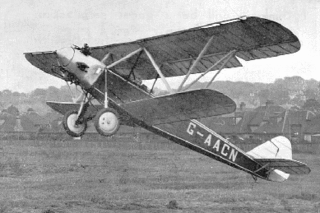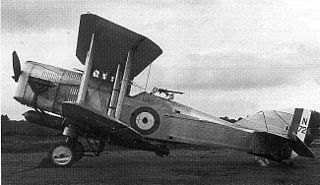
The Curtiss XP-62 was a prototype single-engine interceptor aircraft, that was built at the request of the United States Army Air Forces, by the Curtiss-Wright Corporation. It first flew in 1943.

The Handley Page H.P.39 is a wooden biplane that was constructed in 1929. The aircraft was intended to compete in a competition proposed by the Daniel Guggenheim Fund for the Promotion of Aeronautics - the Guggenheim Safe Aircraft Competition. The original working name for the aircraft was the Guggenheim Competition Biplane. The name Gugnunc was at first unofficial, coming from the Pip, Squeak and Wilfred newspaper cartoon, but it later became official.

The Curtiss P-6 Hawk is an American single-engine biplane fighter introduced into service in the late 1920s with the United States Army Air Corps and operated until the late 1930s prior to the outbreak of World War II.

The Curtiss SC Seahawk was a scout seaplane designed by the Curtiss Aeroplane and Motor Company for the United States Navy. The existing Curtiss SO3C Seamew and Vought OS2U Kingfisher were gradually replaced by the Seahawk in the late stages of the war and into peacetime.

The Curtiss 18T, unofficially known as the Wasp and by the United States Navy as the Kirkham, was an early American triplane fighter aircraft designed by Curtiss for the US Navy.

The Curtiss R2C was a racing aircraft designed for the United States Navy in 1923 by Curtiss. It was a single-seater biplane with a monocoque fuselage and staggered single-bay wings of unequal span braced with I-struts. The aircraft's advanced streamlining featured a top wing mounted directly to the top of the fuselage and surface-mounted radiators for cooling the engine. The aircraft was originally designed and built as a landplane under the Navy designation R2C-1, of which two examples were produced. One was converted into a seaplane version known as the R2C-2 the following year.

The Curtiss Eagle was an airliner produced in small numbers in the United States shortly after World War I. The aircraft was a conventional biplane with three-bay, unstaggered wings of equal span. The fuselage was a very advanced design for its day, incorporating careful streamlining of its monocoque structure, and offering the crew as well as the passengers a fully enclosed cabin. The Eagle is sometimes named as the first American tri-motor aircraft; however Curtiss' own Model H flying boat flew with three engines for a time in 1914 before being converted back to twin-engine configuration.

The Curtiss-Wright CW-1 Junior, originally named the Curtiss-Robertson CR-1 Skeeter is a light sports aircraft produced in the United States in the 1930s. It had been intended to sell it for the price of a mid-range automobile.

The Curtiss XBT2C was a prototype two-seat, single-engined dive/torpedo bomber developed during World War II for the United States Navy. Derived from the Curtiss SB2C Helldiver dive bomber, it was an unsuccessful competitor to meet a 1945 Navy specification for an aircraft to combine the roles that previously required separate types. Unlike the other competitors, the XBT2C was designed to accommodate a radar operator.

The P.W.S.8 was a 1930 Polish sports plane, constructed by the Podlaska Wytwórnia Samolotów (PWS), that remained a prototype.

The Handley Page Hanley was a British torpedo bomber aircraft of the 1920s. A single-engine, single-seat biplane intended to operate from the Royal Navy's aircraft carriers, it was not successful, with only three aircraft being built.

The Handley Page Hendon was a British torpedo bomber of the 1920s. A two-seat development of Handley Page's earlier single-seat Hanley, the Hendon was a single-engine biplane. While six aircraft were purchased by the British Air Ministry for evaluation and trials purposes, no further production ensued and the Hendon did not enter squadron service.

The Gloster III was a British racing floatplane of the 1920s intended to compete for the Schneider Trophy air race. A single-engined, single-seat biplane, two were built, with one finishing second in the 1925 race.

The Handley Page Type S, or HPS-1 was a prototype British carrier-based fighter developed for the United States Navy in the early 1920s. A low-wing monoplane, it was unsuccessful, only two being built and flown.

The Curtiss O-40 Raven was an American observation aircraft of the 1930s which was built and used in small numbers. A single example of the YO-40, a single-engined Sesquiplane with a retractable undercarriage was built, followed by four examples of a modified monoplane version, the O-40B, which remained in use until 1939.

The Curtiss C-1 Canada was a twin-engined bomber aircraft of the First World War which was designed by Curtiss of America to be built by their Canadian subsidiary for the British Royal Naval Air Service and Royal Flying Corps. Although large orders were placed, only twelve were built, the type being rejected in favour of more capable aircraft such as the Handley Page O/100.

The Barnhart Twin 15 "Wampus-Kat" is a twin engine biplane that was built in 1920.

The Curtiss CA-1 was an American five-seat biplane amphibian designed by Frank Courtney and built by Curtiss-Wright at St Louis, Missouri.

The Curtiss Model 22 Cox Racers were two specialised racing aircraft built by the American Curtiss Aeroplane and Motor Company. The type was flown as a monoplane, biplane and triplane.
The Bodiansky 20, a French four-seat touring aircraft flown in the early 1930s, was one of the first French aircraft to adopt Handley Page slots to delay the stall and lower landing speed.





















